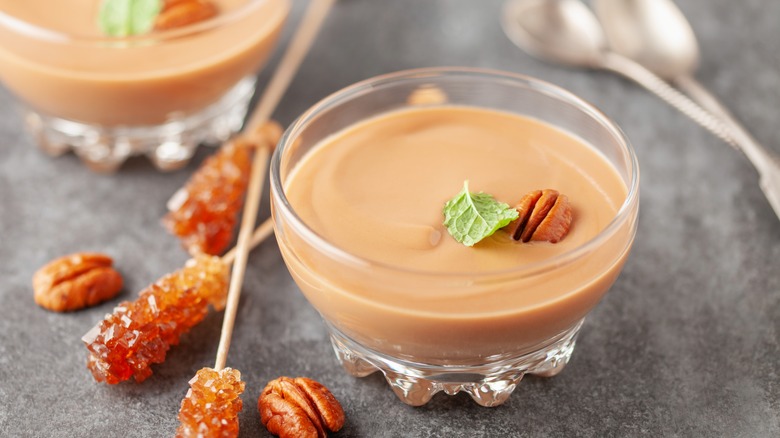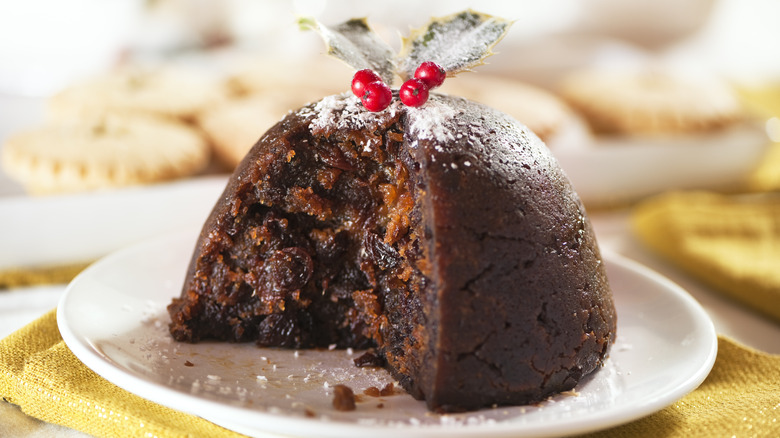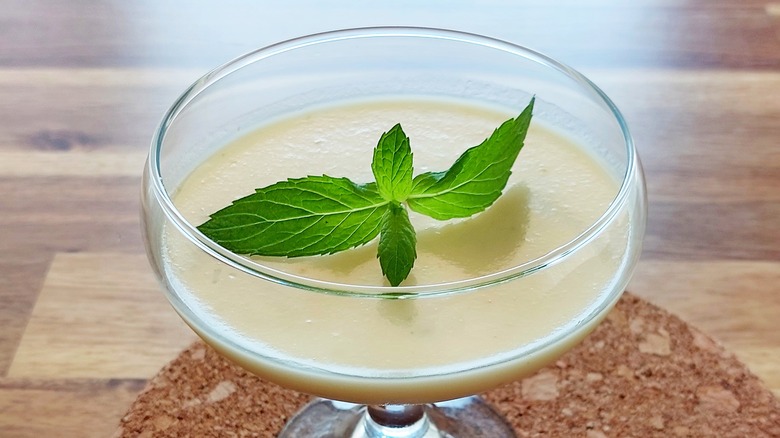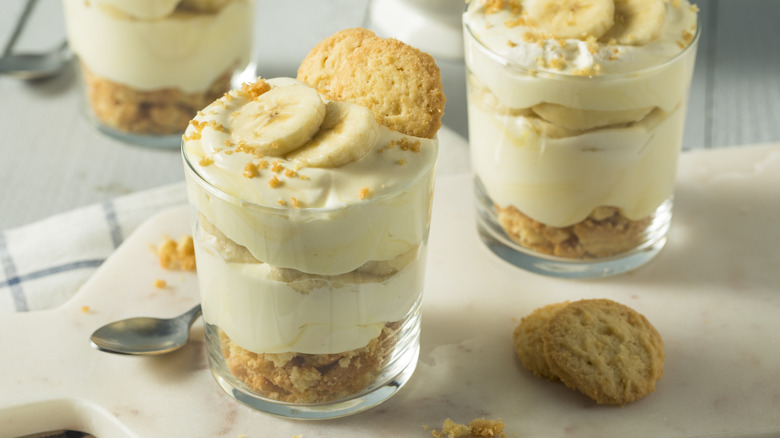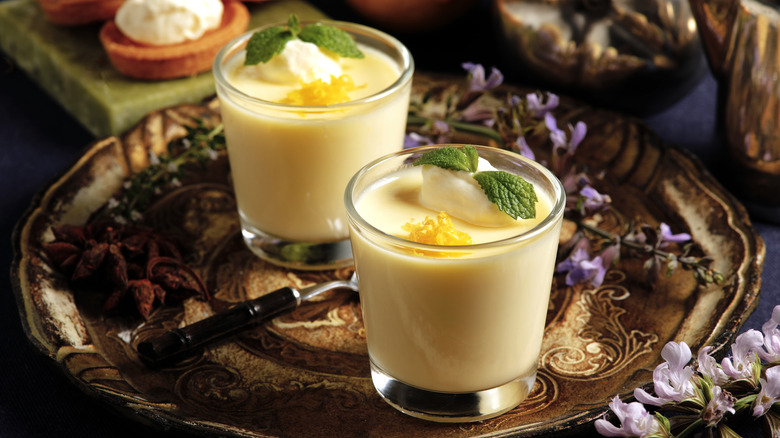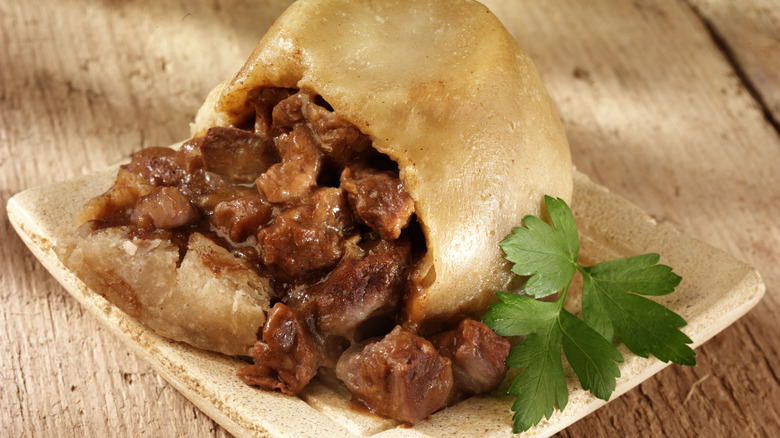What's The Difference Between Posset And Pudding?
You may best know pudding from the chocolate snack packs of your childhood, but this dessert extends far beyond those store-bought pudding brands. While it has mainly become a treat for kids in the U.S., pudding's reach is much more expansive if you venture across the pond. In England, this snack's roots date all the way back to the Middle Ages — and even then, it looked quite a bit different than it does today.
To make matters even more complicated, England also birthed another delicious dessert that's even less known in the States: posset. It's easy to see why people compare the two at first glance; they both hail from Britain, they're both cold desserts you can eat with a spoon, and they both have a soft texture that resembles custard. If you dig a little deeper, though, there are a few key differences between pudding and posset. The distinctions mostly boil down to the ingredients involved in each, the method for making them, and how both of these factors affect the final taste and texture. So, if you're curious to learn about the world of creamy British delicacies, this is your chance.
What is pudding?
At its core, pudding is a very simple dessert. Essentially, it's a thickened milk or cream that's combined with sugar, cooked, and then cooled, although a variety of other ingredients and flavorings can be added in, too. The final product tends to be soft and creamy with a spongy texture. There's plenty of room to pile on toppings, too, as seen in recipes like our Vanilla Chai Spice Pudding with Maple Pecans, which deploys whipped cream, a sprinkle of chai spice, and sweetened nuts.
As we mentioned, pudding stretches far back in England's history — all the way back to the 1600s, to be exact; however, the dessert may actually have roots in 7th-century Persia, and the word "pudding" derives from the Latin word "botellus," meaning "small sausage." That may give you some indication that in 17th-century Britain, this food could be both sweet and savory. Early sweet versions incorporated flour and nuts, while savory versions used blood sausages and animal intestines. In the 1800s, however, we start to see the classic dessert that was made for Christmas, which used dried fruit, spices, suet (saturated fat that comes from animal kidneys), and sugar.
What is posset?
Instead of primarily being a spoonable, solid dessert, posset actually started out as a drink. The lines get blurry from there, though — technically, you could either sip on these early posset cups or dig the treat out with a spoon, and while initial versions resembled a beverage, modern-day versions tend to be more custard-like. The dish's texture is thinner than pudding but thicker than milk, which is why some people liken it to eggnog. Since the most popular type has a light yellow color, its appearance only bolsters that comparison. Plus, it's another boozy beverage that was historically consumed for special occasions, as traditional recipes contained alcohol (typically wine, brandy, or ale), curdled milk or cream, sugar, spices, and — yes — occasionally eggs.
As with pudding, we can trace posset's roots back to the English Middle Ages. In fact, original recipes for posset were recorded as early as the 1600s (and Shakespeare even mentioned the dish in a few of his plays), although it has evolved over time. These early drinks were consumed hot and often featured a light, airy foam on top of the cup. In addition to its delicious taste, posset was thought to have medicinal properties; there's even a record of a doctor prescribing posset to King Charles I in 1620.
Dessert puddings incorporate a thickener
As we've established, there are a plethora of ways to make pudding — especially if you take the English recipes of the Middle Ages into account. For now, though, let's focus on its basic dessert form, or how you'll generally see it in the U.S. The main difference between posset and modern-day pudding is that the latter uses a thickener. At its simplest, it requires milk, sugar, a thickener (typically cornstarch), a little salt, butter, and any desired flavorings. Some recipes also incorporate eggs, and others swap out the sugar for maple syrup or honey and the cornstarch for tapioca flour. You can use a wide variety of ingredients to flavor your pudding; some standard varieties include vanilla, chocolate, and almond, though you can also branch out and try pistachio pudding or banana pudding.
To make this dessert, you'll first want to mix your cornstarch with a little milk, then separately bring the rest of the milk to a simmer. All the other ingredients then go in the pot (except for the butter and any flavorings), and everything gets stirred together until it thickens up. Only after pulling your mixture off the stove will you stir in the butter and flavoring, after which you'll divide and cool your pudding.
Modern-day posset has morphed into a lemony custard
While the posset of yore was a spiced drink that may have shared more traits with eggnog than with pudding, the modern-day version is much more dessert-like. And while the recipes from the Middle Ages used a fairly long ingredient list, the updated one is relatively short. All you really need are heavy cream, sugar, and lemons. This newer lemon posset recipe stems from varieties made in the 1600s and 1700s that included citrus (typically lemons and oranges), along with almonds and breadcrumbs.
Once again, though, today's dessert is much simpler to whip up. You just have to simmer your heavy cream and sugar until the sugar dissolves, then take the pot off the stove and stir in lemon zest and juice. This is essentially the whole process — after you've combined everything, you'll just split up the mixture between ramekins, glasses, or jars and place them in the fridge until they're cool. Popular garnishes today include mint sprigs, berries (blueberries, raspberries, blackberries, and strawberry slices), berry jam, powdered sugar, sliced almonds, shortbread cookies, and more lemon zest.
Posset is always sweet, but today's British puddings can still be savory
As you've probably gathered by now, the modern-day meanings of both pudding and posset are quite different from their original, centuries-old definitions. While we discussed the simplest form of pudding, the word can actually encompass a range of treats in today's British culture — both sweet and savory. This is in stark contrast to posset, which is only sweet. Across the pond, you'll find everything from spotted dick (a steamed pudding with vanilla custard and currants) to sticky figgy pudding (a dish similar to cake) to Yorkshire pudding (a savory dish that resembles a popover). Steak and kidney pudding is another classic British recipe in which steak, kidneys, and gravy are enclosed in a pastry.
On the flip side, the popular definition for posset seems to have only narrowed over time. The treat has been gaining steam on TikTok since 2023, where users serve it out of aesthetically pleasing lemon peels in videos with millions of views. Some versions even torch the top of the posset so it looks a bit like a crème brûlée. So, if you want to upgrade your custardy desserts beyond the pudding packages of your childhood, you may want to give these fancier modern recipes a whirl.
